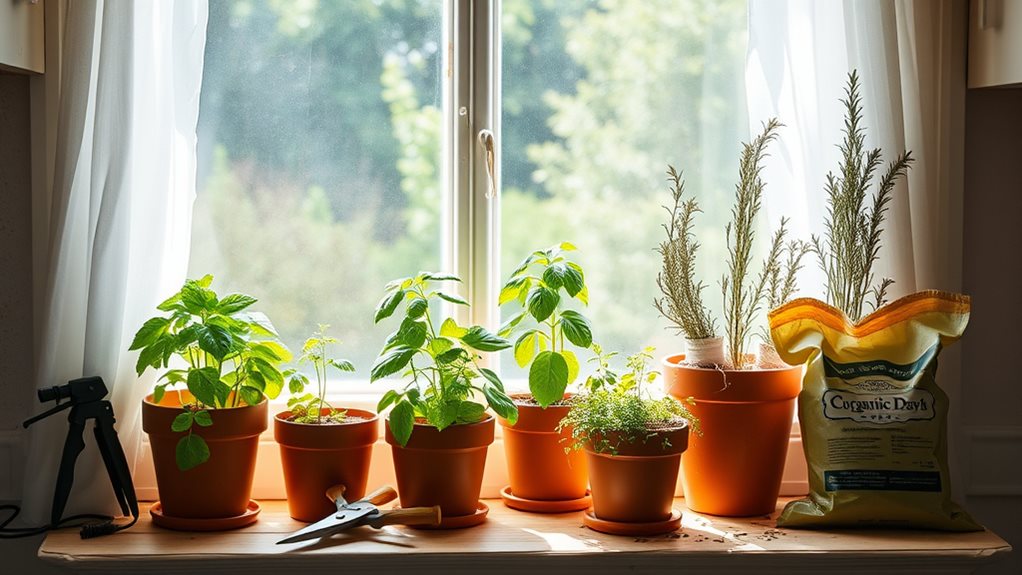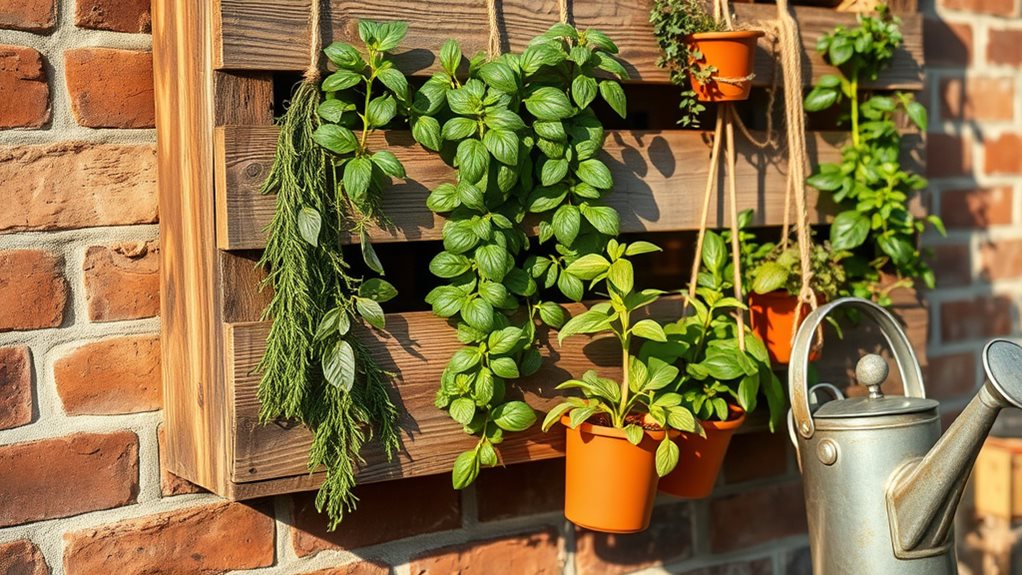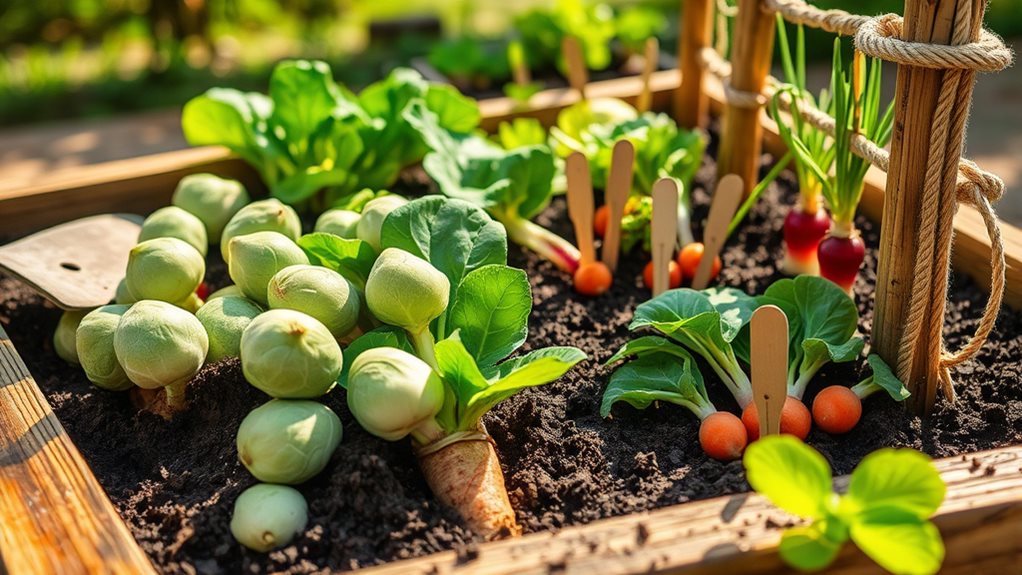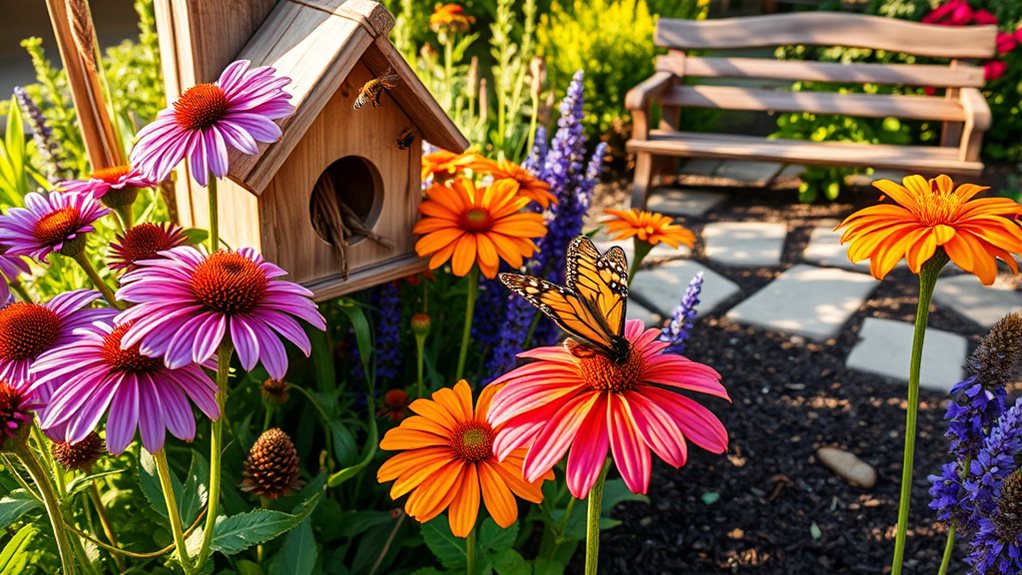Where to dig in?
Start your gardening journey with these simple gardening ideas: grow herbs like basil and mint in a sunny windowsill, create low-maintenance container gardens with drought-tolerant plants, or try vertical gardening to save space. For beginners, a small 4×4 raised vegetable bed with lettuce and tomatoes offers rewarding results. Don’t forget to attract pollinators by planting native wildflowers in sunny spots and avoiding pesticides. These accessible approaches will transform even the smallest spaces into thriving green havens.
Growing Fresh Herbs on Your Windowsill

While outdoor gardens require significant space and upkeep, growing herbs on your windowsill offers a practical solution for fresh flavors year-round. Choose a south or southwest-facing window that provides at least 4-6 hours of direct sunlight daily to guarantee robust growth. Most herbs perform wonderfully when placed next to a cool windowpane, with basil being the only exception that prefers warmer locations.
Fresh herbs at your fingertips without garden hassle—just a sunny windowsill and minimal effort.
Getting Started
- Select suitable herbs like basil, thyme, mint, or chives
- Use small pots with drainage holes and a layer of pebbles at the bottom
- Fill with high-quality organic vegetable compost
- Limit to 2-4 plants per container to prevent overcrowding
For optimal growing conditions, consider adding peat moss to your soil mix to improve moisture retention while maintaining proper drainage. For lower light conditions, supplement with grow lights to facilitate healthy development. You can also try growing herbs hydroponically in water, changing it every 1-2 weeks. Harvest by cutting near the base to encourage regrowth, and fertilize regularly to replenish nutrients in the limited soil.
Creating a Low-Maintenance Container Garden

If you’ve ever wanted to garden but don’t have much time for upkeep, container gardening offers the perfect solution for busy plant lovers. Start by selecting drought-tolerant plants like cacti, succulents, and salvias that thrive with minimal attention. Consider using the “Thriller, Filler, Spiller”(concept) to create visually balanced container arrangements. For stylish indoor spaces, try adding a Kalanchoe Flapjack with its architectural form and sun-induced pink edges.
Choose the right containers for your space and needs:
- Self-watering containers reduce watering frequency
- Terracotta pots provide excellent drainage
- Lightweight fabric planters work well in small spaces
Place sun-loving plants in direct sunlight and shade-tolerant varieties in cooler spots. Use quality potting soil that drains well, and apply controlled-release fertilizers to minimize maintenance. Create visual interest by combining plants of different heights, colors, and textures. For the easiest care routine, group plants with similar water requirements together, allowing you to water more efficiently.
Space-Saving Vertical Garden Solutions

When space is limited in your home or yard, vertical gardening offers an innovative solution that transforms walls, fences, and other upright surfaces into thriving green spaces. This growing trend, valued at $1.2 billion in 2024, brings multiple benefits beyond just maximizing your gardening area.
Creating your vertical garden is simpler than you might think:
- Install a sturdy structural support system on your chosen wall or fence
- Set up a drip irrigation system to distribute water efficiently through plant rows
- Choose appropriate growing media, either soil-based or hydroponic
- Select plants that thrive in vertical settings based on your light conditions
Vertical gardens require minimal bending, making them perfect for seniors or those with limited mobility. They’ll also improve your air quality, enhance your home’s appearance, and help reduce energy costs through natural insulation. With advancements in technology, some modern vertical gardens now incorporate AI-based monitoring systems that can track plant health and optimize watering schedules in real-time. For even greater efficiency, consider implementing soil-free hydroponics which uses significantly less water than traditional gardening while producing faster growth and higher yields.
Beginner-Friendly Vegetable Patch Ideas

Starting your first vegetable garden doesn’t need to be complicated or overwhelming. Choose a spot that gets at least six hours of sunlight daily, and make sure it’s near a water source for easy maintenance. Starting small with a 4×4-foot raised bed is perfect for beginners who want to test their gardening skills without becoming overwhelmed.
| Beginner Vegetables | Planting Season | Space Needed |
|---|---|---|
| Lettuce & Radishes | Spring/Fall | 4-6 inches |
| Tomatoes & Cucumbers | Summer | 18-24 inches |
| Carrots & Beans | Spring | 3-6 inches |
Before planting, test your soil and add compost to improve fertility. Remove any rocks or weeds, then loosen the soil with a garden fork. Be sure to gently loosen any root-bound plants before placing them in the soil. When planting, follow spacing guidelines on seed packets to prevent overcrowding. Water regularly, keeping soil moist but not waterlogged. Harvest vegetables at their peak for maximum flavor and nutrition.
Attracting Beneficial Pollinators to Your Garden

Your vegetable garden will thrive even more with the help of nature’s gardening assistants – pollinators. Creating a welcoming environment for bees, butterflies, and other helpful creatures isn’t difficult, and the rewards are bountiful harvests.
Choose a mix of plants that bloom throughout the seasons to provide year-round nectar sources. Native wildflowers like coneflowers and milkweed work wonderfully alongside herbs such as rosemary and basil. According to the Royal Horticultural Society, incorporating plants with single flowers rather than double blooms provides better pollinator accessibility to nectar and pollen. For those seeking to cultivate flower varieties specifically for pollinators, Floret Farm’s guide offers excellent advice on sustainable cut flower gardening.
A diverse garden with season-spanning blooms nourishes pollinators and enriches your harvest with nature’s perfect partnership.
Plant in sunny spots with average to moist soil conditions
Include a variety of flower shapes and colors to attract different pollinators
Avoid pesticides that harm beneficial insects
Leave some leaf litter and plant stalks for winter habitat
Remember to incorporate both early bloomers like spotted geranium and late-season options such as goldenrod and asters. This diversity guarantees your garden remains a pollinator haven all year.
Frequently Asked Questions
How Do I Properly Winterize My Garden?
To winterize your garden:
- Clear out debris and dead plants from your beds
- Test your soil and make necessary pH adjustments
- Apply a thick layer of mulch around plants to insulate their roots
- Cover sensitive plants with frost blankets or burlap
- Create windbreaks to protect against harsh winter conditions
- Cut cover crops to ground level and plan your spring layout
- Guarantee soil has adequate moisture before the first freeze
What Gardening Tasks Should Be Done During Each Season?
Spring:
Focus on soil preparation, adding fertilizer to your garden beds.
Plant cool-season crops like broccoli and spinach, and start seeds indoors for summer vegetables.
Prune shrubs and apply pre-emergent herbicides.
Summer:
Plant warm-season crops once soil warms.
Water efficiently, mulch to retain moisture, and monitor for pests regularly.
Fall:
Harvest remaining crops, clean up garden debris, and divide perennials.
Add compost to soil.
Winter:
Prune dormant trees, protect sensitive plants, and plan next year’s garden.
How Can I Test and Amend My Soil Ph?
To test your soil pH:
- Collect samples 4-6 inches deep from multiple garden spots
- Remove debris and mix with distilled water
- Use pH testing strips, a digital meter, or probe to measure
To amend your pH:
- For acidic soil (below 7), add lime to raise pH
- For alkaline soil (above 7), add sulfur to lower pH
- Wait several weeks after amendments before retesting
You’ll need patience, as pH changes gradually after treatment.
When Should I Divide Perennial Plants?
Divide your perennials when you notice:
- Reduced blooming
- Bare spots in the center
- Weak, falling stems
- Sparse foliage
For summer-flowering varieties, divide in spring (March-May) when new growth appears. For spring bloomers, divide in fall (mid-September to mid-October), giving roots time to establish before frost. Always divide when plants aren’t flowering, and water thoroughly before and after.
Most perennials benefit from division every 3-5 years to maintain their vigor.
How Do I Create a Rain Garden for Water Conservation?
To create a rain garden:
- Choose a location that’s at least 10 feet from your home, in a natural low spot.
- Dig a shallow depression, about 6-8 inches deep.
- Add compost to improve drainage.
- Select native plants that tolerate both wet and dry conditions.
- Arrange taller plants in the center, shorter ones around edges.
- Add mulch to reduce weeds.
- Water regularly until plants establish themselves.
Conclusion
You’ve now got all the tools to start your gardening journey, regardless of your space or experience level. Try implementing just one idea this weekend, then gradually add more as your confidence grows. Remember, gardening is a process of continuous learning and experimentation. With these simple approaches, you’ll create beautiful, functional green spaces that bring joy, fresh produce, and natural beauty into your daily life.

